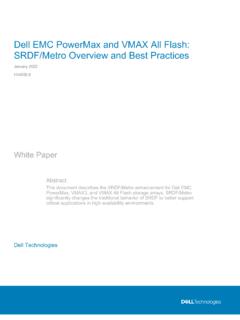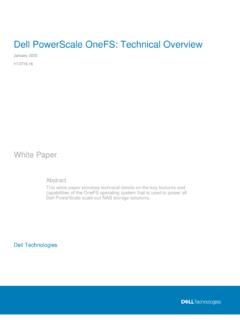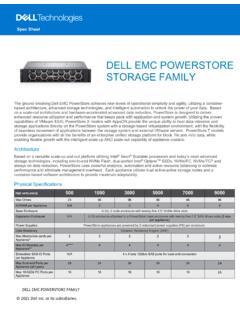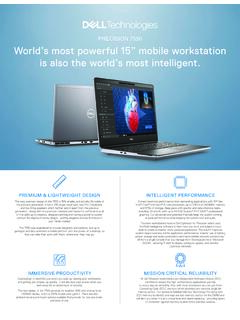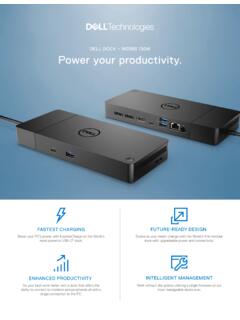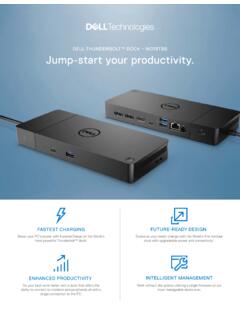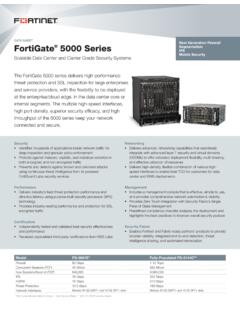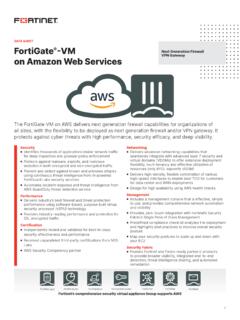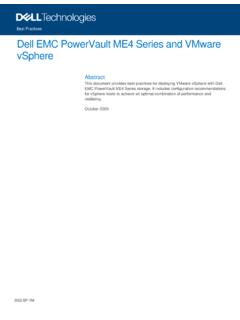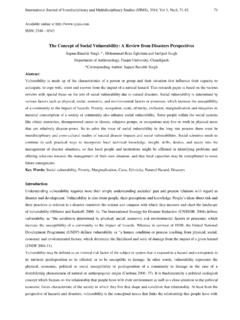Transcription of Dell EMC Unity: VMware vSphere Best Practices
1 best Practices Dell EMC Unity: VMware vSphere best Practices All-flash arrays Abstract This document provides best Practices for deploying VMware vSphere with Dell EMC Unity All-Flash arrays including settings and configuration recommendations for vSphere hosts to achieve an optimal combination of performance and resiliency . August 2020 Revisions 2 Dell EMC Unity: VMware vSphere best Practices | Revisions Date Description July 2017 Initial release for Dell EMC Unity OE version June 2019 Update for Dell EMC Unity XT release November 2019 vVols branding update April 2020 vSphere updates August 2020 Minor corrections Acknowledgments This paper was produced by the following members of the Dell EMC storage engineering team: Authored by: David Glynn Updated by: Darin Schmitz The information in this publication is provided as is.
2 Dell Inc. makes no representations or warranties of any kind with respect to the information in this publication, and specifically disclaims implied warranties of merchantability or fitness for a particular purpose. Use, copying, and distribution of any software described in this publication requires an applicable software license. Copyright 2017 2020 Dell Inc. or its subsidiaries. All Rights Reserved. Dell Technologies, Dell, EMC, Dell EMC and other trademarks are trademarks of Dell Inc. or its subsidiaries. Other trademarks may be trademarks of their respective owners. [8/24/2020] [ best Practices ] [ ] Table of contents 3 Dell EMC Unity: VMware vSphere best Practices | Table of contents 2 Acknowledgements.
3 2 Table of contents .. 3 Executive summary .. 4 1 Storage configuration .. 5 Storage pools .. 5 2 Dell EMC Unity features .. 7 FAST VP .. 7 FAST Cache .. 7 Compression .. 7 Data at Rest Encryption .. 8 Host I/O limits .. 8 3 VMware vSphere 9 Fibre Channel switch zoning .. 9 Mapping storage to a vSphere 10 Multipathing .. 10 iSCSI LUNs .. 10 LUN sizing and creation .. 11 Guest virtual SCSI adapter selection .. 11 Thin provisioning and virtual 12 VMware NFS datastores .. 13 Virtual Volumes .. 13 4 Data protection .. 14 AppSync .. 14 Snapshots .. 14 Asynchronous replication.
4 14 Synchronous replication .. 14 A Technical support and resources .. 16 Related resources .. 16 Executive summary 4 Dell EMC Unity: VMware vSphere best Practices | Executive summary This guide provides best Practices for customers using Dell EMC Unity All-Flash storage systems in a VMware vSphere environment. This paper focuses on optimizing system performance and maximizing the usability of Dell EMC Unity automated storage features when used with VMware vSphere . For general best Practices on using Dell EMC Unity systems, see the Dell EMC Unity: best Practices Guide. These guidelines are intended to cover the majority of use cases.
5 They are strongly recommended by Dell EMC but are not strictly required. This paper was developed using the Dell EMC Unity XT 480F All-Flash array, but is also applicable when using the 380F, 680F, or 880F Dell EMC Unity XT All-Flash arrays. If you have questions about the applicability of these guidelines in your environment, contact your Dell EMC representative to discuss the appropriateness of the recommendations. Storage configuration 5 Dell EMC Unity: VMware vSphere best Practices | 1 Storage configuration Dell EMC Unity is a virtually provisioned, flash-optimized storage system designed for ease of use. This paper covers the all-flash array models.
6 This section describes the foundational array technologies that support the application-specific sections that follow. Additional information for this section can be found in the Dell EMC Unity best Practices Guide. Storage pools As of Dell EMC Unity OE version , Dell EMC Unity supports two types of storage pools on all-flash storage systems: traditional pools and dynamic pools. Traditional pools apply RAID protection to discrete groups of drives within the storage pool. Dynamic pools apply RAID to groups of drive extents from drives within the pool and allow for greater flexibility in managing and expanding the pool.
7 Dynamic pools must be configured from all-flash drives; dynamic pools cannot be built with HDDs. In general, it is recommended to use a small number of storage pools within Dell EMC Unity storage to reduce complexity and increase flexibility. However, it may be appropriate to configure additional storage pools in the following cases: Separate workloads with different I/O profiles Dedicate resources to meet specific performance goals Separate resources for multi-tenancy Create smaller failure domains Refer to the Dell EMC Unity: Dynamic Pools white paper for additional information. Storage pool capacity Storage pool capacity is used for multiple purposes: To store all data written into storage objects LUNs, file systems, datastores, and VMware vSphere Virtual Volumes (vVols) in that pool To store data that is needed for snapshots of storage objects in the pool To track changes to replicated storage objects in that pool Storage pools must maintain free capacity to operate properly.
8 By default, Dell EMC Unity systems will raise an alert if a storage pool has less than 30% free capacity and will begin to automatically invalidate snapshots and replication sessions if the storage pool has less than 5% free capacity. Dell EMC recommends that a storage pool always has at least 10% free capacity. Storage configuration 6 Dell EMC Unity: VMware vSphere best Practices | All-flash pool All-flash pools provide the highest level of performance in Dell EMC Unity arrays. Use an all-flash pool when the application requires the highest storage performance at the lowest response time. Dell EMC FAST Cache and FAST VP are not applicable to all-flash pools.
9 Compression is only supported on an all-flash pool. Snapshots and replication operate most efficiently in all-flash pools. Dell EMC recommends using only a single drive size and a single RAID width within an all-flash pool. For example, for an all-flash pool, use only TB SAS flash 3 drives and configure them all with RAID 5 8+1. Hybrid pool Hybrid pools are not applicable when using Dell EMC Unity All-Flash arrays. Dell EMC Unity features 7 Dell EMC Unity: VMware vSphere best Practices | 2 Dell EMC Unity features This section describes some of the native features available on the Dell EMC Unity platform.
10 Additional information on each of these features can be found in the Dell EMC Unity: best Practices Guide. Features not applicable to the all-flash array models covered by this paper are noted. FAST VP FAST VP accelerates performance of a specific storage pool by automatically moving data within that pool to the appropriate drive technology based on data access patterns. FAST VP is only applicable to hybrid pools within a Dell EMC Unity Hybrid flash system. FAST Cache FAST Cache is a single global resource that can improve performance of one or more hybrid pools within a Dell EMC Unity Hybrid flash system. FAST Cache can only be created with SAS flash 2 drives, and is only applicable to hybrid pools.

